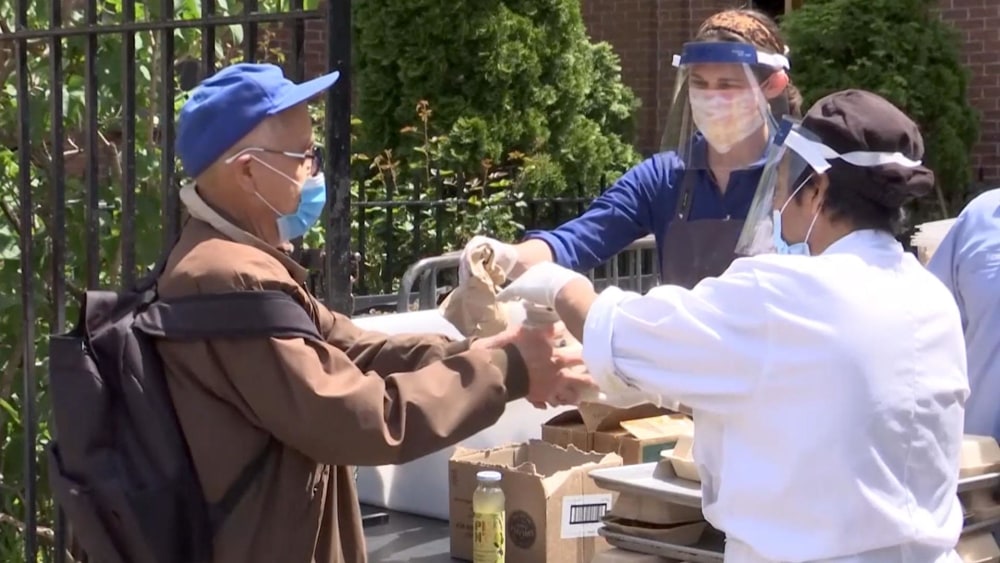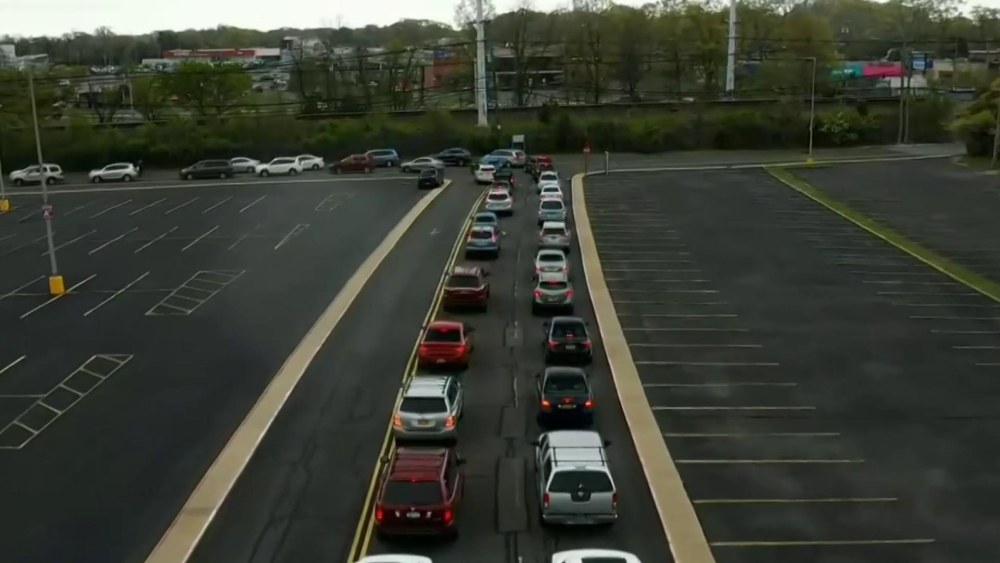By Martha C. White (NBC News)
As jobs vanish, incomes drop and food prices rise, more Americans are going to bed hungry — and advocates warn that without intervention from Congress, those numbers could rise to a level unseen in modern times.
“People who never thought they'd experience food insecurity are now seeking food assistance,” said Luis Guardia, president of the nonprofit Food Research & Action Center.
A study from Northwestern University's Institute for Policy Studies found that the pandemic roughly doubled food insecurity in the United States. The food assistance nonprofit Feeding America estimates that with household finances decimated by the coronavirus, around 40 percent of people visiting food banks are first-time recipients of food assistance.

“The demand is unprecedented and unlike any challenge that we've faced in food bank history in the United States. We’ve really never seen the level of need that we’re seeing now, and having seen it come about as quickly as it’s come about, it’s been a real shock,” said Katie Fitzgerald, chief operating officer at Feeding America. “It’s been a perfect storm in that the demand has been unprecedented and the supply of food has been pretty significantly disrupted.”
“It’s just a mad dash to make sure nobody’s going hungry during COVID,” said Christopher Robertson, director of Market to HOPE, a food pantry that operates within Catholic Charities of Southeast Texas. “The folks we’re seeing now are new people. A little less than half of the people who came in during the month of June were brand new people."
Families, seniors and communities of color have been hit especially hard, experts say.
DeLisa Booker, a retired resident of Beaumont, Texas, said she relies on the Market to HOPE to stretch disability payments for her and her husband, especially since supply chain disruptions have sent prices for staples, especially meat and dairy, skyrocketing. “Meat is ridiculous. It’s like $8 for a pack of ground meat, and it’s harder to get what you need on a fixed income,” she said.
A diabetic with chronic kidney disease and heart problems, the 59-year-old Booker said frequent medical appointments take a toll on her budget. “Market to HOPE mostly has what I need — the canned goods, the milk, the eggs,” she said. “It really is a blessing.”
The Brookings Institution found that, by the end of April, roughly 40 percent of families with children younger than 13 were food insecure, and the widespread school closures brought about by the pandemic have put an added strain on families’ grocery budgets.
“Among African American households with children, you’re seeing levels of 39 percent saying they’re food insecure,” said Asma Lateef, director of Bread for the World Institute. The number for Latino households with children reporting food insecurity was similar, at 37 percent, compared to 22 percent of white households.
“There are issues around historic systemic racism,” Lateef said, that make nonwhite populations more vulnerable to food insecurity. “They tend to work in jobs that pay less,” she said, including many of the service-sector jobs that have been hardest-hit by the COVID-19-related shutdowns.
“Historically, they've had higher rates of poverty and food insecurity. This crisis is no different,” Lateef said, although she added that anecdotal evidence suggests lower-income workers face greater difficulty securing unemployment insurance because they are more likely to lack access to a computer or high-speed internet.
Some of the biggest fundraisers for food banks — annual galas and award nights — have been postponed indefinitely due to COVID-19.
This cascade of challenges comes as nonprofits and the food banks they serve are tightening their belts at an organizational level: Charities’ biggest fundraising vehicles — annual galas and award nights — are postponed indefinitely due to COVID-19. Expenses are higher as a result of the added supplies and labor needed to prepackage food for distribution. And aid agencies that receive government funding see themselves in the crosshairs of inevitable budget cuts as the recession erodes
Food bank operators also worry that the protocols the pandemic has forced them to implement — prepackaged boxes, curbside pickups and little additional interaction — are robbing them of the opportunity to assist some of the most vulnerable members of society.
“The charitable food system does more than distribute food,” Fitzgerald said. “A lot of our food banks and agencies provide more comprehensive services. But that requires sitting down with people and talking to them” — the kind of interaction that flies in the face of social distancing protocols.
Market to HOPE’s clients include many undocumented immigrants, who often are either ineligible for benefits or unwilling to risk deportation by applying, Robertson said. “There’s no one coming to the rescue, to a certain extent. There's such a fear right now. It makes it hard for them to trust us.”
Joey Keys, CEO of the Southeast Missouri Food Bank, said his organization saw a sharp acceleration in the early days of the pandemic, and demand is now running 25 to 30 percent higher than it was pre-pandemic. “We would have people lining up hours beforehand to receive food. A lot of it was first-time people needing assistance,” he said.

One of those people was Bailey Hennecke. “I assume there’s probably a lot of people in the same boat as us,” she said.
A part-time gymnastics coach and accounting student planning to graduate in December, Hennecke, 22, and her husband had just bought a new home in rural southern Missouri when the pandemic hit. “We bought our first house at the end of March, right before all the virus,” she said. “Everything started happening right when we bought the house.”
The gym where Hennecke coached suspended operations and her husband was sent home from his factory job, then laid off two weeks later. With their first mortgage payment due in May, they decided to prioritize that bill. Both took any work they could find — a Sonic fast-food outlet for him, a Dollar Tree store for her — but Hennecke said the combination of spotty hours and low hourly pay sliced their usual income in half.
“Nobody wants to act like they need help,” she said, but the couple, who also have part-time custody of Hennecke’s 7-year-old stepson, quickly realized that they would need additional assistance and reached out to the Southeast Missouri Food Bank.
“This kind of takes your world and turns it upside down, thinking you're in a great spot having this new house and all these new things — it’s all gone in a couple weeks,” Hennecke said.
“This kind of takes your world and turns it upside down, thinking you're in a great spot having this new house and all these new things — it’s all gone in a couple weeks."
Some advocates who work with low-income populations say that when people feel forced to choose between paying for food and paying for shelter, that’s indicative of a bigger problem.
“My concern is that in the months to come, we're talking about potential unemployment benefits running out and eviction moratoriums coming to an end,” said Jose Ramirez, executive director of St. Anthony’s, a nonprofit in San Francisco that provides meals and other assistance to the homeless and others in need. Either of these two events could be the tipping point for many of the people St. Anthony’s serves, he said. Combined, he predicted that the impact could be devastating.
“I think there is a big wave of folks that are going to be suffering economic hardship that are in need of basics like food and housing,” he said. “It’s a moment of reflection to think about what our priorities are.”
Feeding America’s Fitzgerald said Congress needs to extend the enhanced unemployment insurance benefits that are scheduled to expire at the end of July, and commit to higher funding levels for the Supplemental Nutrition Assistance Program and other initiatives. “It has buffered, to a great extent, the immediate challenge of securing food for families who suddenly found themselves without jobs,” she said.
“What we are concerned about is the unemployment benefits are going to be discontinued at the level they are at right now and unless we have additional investment … we’re going to have a very significant gap,” between the food people have and what they need, she said. Feeding America predicts an 8 billion meal gap over the next year if policymakers don’t act.
“People are living paycheck to paycheck already,” Keys said. “We’re kind of in a preparing mode, but you can only prepare for what you know. We’re all unsure.”
As a growing number of states, including Texas, battle rising COVID-19 case numbers, Robertson said he worries about what the future holds. “When things started to open again and the stimulus came out, there was a little bit of a dip, but it didn’t last. Our biggest month to date was June.”
“There's going to be a growing need, an enormous wave of people who are going to need our services,” Ramirez said. “We alone can't create a strong enough safety net for the need that’s coming.”